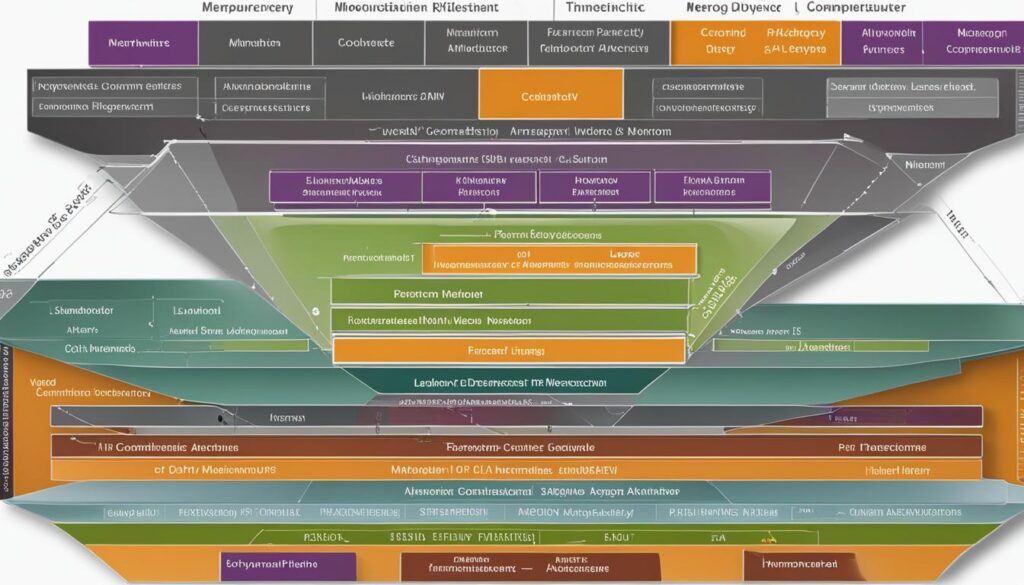Welcome to our guide on understanding kernels in information technology. In this article, we will provide you with a comprehensive definition of a kernel, with a focus on the operating system kernel. A kernel is a crucial component of a computer’s operating system, serving as the fundamental bridge between the software and hardware components. It provides essential services and functionalities that allow the operating system to function effectively.
The kernel plays a vital role in various aspects of a computer system, including managing processes, allocating memory, controlling hardware devices, and facilitating communication between different software components. Without a properly functioning kernel, an operating system may experience instability and performance issues.
There are different types of kernels, each with its own architecture and allocation of address spaces. These include monolithic kernels, microkernels, and hybrid kernels. Each type offers unique advantages and characteristics that cater to specific needs and requirements.
Contents
- 1 The Purpose of the Kernel
- 2 The Components and Architecture of a Kernel
- 3 Types of Kernels
- 4 Role of the Kernel in a Jupyter Notebook
- 5 Conclusion
- 6 FAQ
- 6.1 What is a kernel in information technology?
- 6.2 What are the functions of a kernel?
- 6.3 Why is the kernel important in IT?
- 6.4 What are the different types of kernels?
- 6.5 What is the role of the kernel in a Jupyter Notebook?
- 6.6 What are some common kernels in modern operating systems?
- 6.7 What is the summary of the importance of the kernel in IT systems?
- 7 Source Links
Key Takeaways
- A kernel is the core part of an operating system, providing basic services for all other parts of the system.
- It handles tasks such as process and memory management, device control, and networking.
- There are different types of kernels, including monolithic, microkernel, and hybrid, each with its own architecture and allocation of address spaces.
- The kernel plays a critical role in the smooth execution of user requests and optimal resource allocation.
- Understanding the functions and importance of kernels is essential for anyone working with computers and software development.
The Purpose of the Kernel
The kernel serves as the backbone of an operating system, performing crucial functions that are vital to the smooth operation of a computer system. Its importance in the field of information technology cannot be overstated.
The primary functions of a kernel include:
- Loading and managing OS components
- Organizing and managing threads and processes
- Scheduling resource usage
- Handling memory allocation and management
- Optimizing hardware resources
- Managing input/output devices
Without a properly functioning kernel, the operating system and applications may encounter various issues, such as system instability and performance problems. The kernel acts as the bridge between users/applications and the computer hardware, ensuring that user requests are executed smoothly and resources are allocated efficiently.
Imagine the kernel as the conductor of an orchestra, coordinating different processes and ensuring they work in harmony to produce a flawless performance.
Just like the conductor guides the musicians, the kernel directs the various components of the system to work together seamlessly.
Every interaction you have with a computer, whether it’s launching an application, copying files, or printing a document, relies on the kernel’s functionality. It provides the necessary interfaces for users and applications to interact with the computer and ensures that these interactions are executed accurately and efficiently.
The kernel plays a crucial role in information technology, making it an essential component of any computer system. Its proper functioning is pivotal in maintaining system stability, optimizing resource utilization, and providing a seamless user experience.
A better understanding of the functions and importance of the kernel in IT systems helps professionals in areas such as software development and system administration to make informed decisions and troubleshoot issues effectively.
The Components and Architecture of a Kernel
A kernel consists of different layers and components that work together to provide the functions and services of an operating system. The architecture of a kernel includes multiple layers, such as hardware, memory management, process management, device management, and file system.
- Hardware Layer: This layer interfaces with the system hardware, facilitating communication between the operating system and physical components.
- Memory Management Layer: The memory management layer is responsible for allocating memory to running processes, ensuring efficient utilization of available resources.
- Process Management Layer: This layer manages the execution of different processes within the operating system. It handles tasks such as process scheduling, timing, and synchronization.
- Device Management Layer: The device management layer ensures proper communication between the operating system and external devices through device drivers. It facilitates the integration and control of hardware peripherals.
- File System Layer: The file system layer is responsible for assigning processes to designated areas on the hard disk. It manages the storage and retrieval of data and facilitates file operations.
These layers build upon each other, with each higher layer relying on and utilizing the functionalities provided by the layers below it. The components and architecture of a kernel form the foundation for the smooth operation of an operating system, enabling it to perform tasks effectively and efficiently.

Types of Kernels
Kernels play a crucial role in an operating system, providing the foundation for its functionality and performance. They can be classified into different types based on their architecture and capabilities. Let’s explore the three main types of kernels: monolithic, microkernel, and hybrid kernel.
Monolithic Kernel
A monolithic kernel is a unified entity that handles all the essential tasks of an operating system. It directly interacts with the hardware, taking charge of memory and process management, hardware management, and device management. Examples of operating systems that utilize a monolithic kernel are Windows and Linux. The monolithic kernel design offers a straightforward and efficient approach, allowing for direct access to system resources.
Microkernel
Unlike a monolithic kernel, a microkernel delegates most of its services to user space, resulting in a more modular and resilient architecture. It focuses on providing the bare minimum functionality to the kernel and offloads additional services to user processes. Message passing is commonly used to facilitate communication between processes. An example of an operating system employing a microkernel design is MINIX 3.
Hybrid Kernel
Hybrid kernels combine the best features of monolithic and microkernel architectures. They aim for a more compact and modular design while maintaining the flexibility and performance advantages of a monolithic kernel. The Linux and macOS kernels are excellent examples of hybrid kernels. These kernels strike a balance between the efficient resource utilization of a monolithic approach and the modularity and resilience of a microkernel architecture.
The variety of kernel types allows for flexibility in designing and implementing operating systems, catering to specific requirements and priorities. Whether it’s the comprehensive control of a monolithic kernel, the modularity of a microkernel, or the versatility of a hybrid kernel, each type serves a distinct purpose in the realm of information technology.
Role of the Kernel in a Jupyter Notebook
When you open a Jupyter Notebook, a kernel is automatically launched alongside it. This kernel is specific to the programming language you are using, such as Python, and plays a crucial role in executing the code within the notebook.
The Jupyter Notebook kernel allows you to execute individual code blocks and see the results in real-time. This enables you to work with the code interactively, making it easier to test and debug your programs.
Moreover, the Jupyter Notebook kernel provides various commands that help you manage the execution of your code and optimize memory usage. These commands include interrupting processes, restarting and running all cells, restarting the kernel, reconnecting to the kernel, and shutting down the kernel.
To give you a better understanding, here’s an example of the available commands:
Interrupting processes: This command allows you to stop the execution of a code cell that is taking longer than expected to run.
Restarting and running all cells: This command restarts the kernel and executes all the code cells from the beginning, ensuring a fresh start.
Restarting the kernel: This command restarts the kernel, clearing all the variables and resetting the notebook’s state.
Reconnecting to the kernel: If your notebook loses connection to the kernel, this command helps you regain the connection without losing your progress.
Shutting down the kernel: This command terminates the kernel, closing the notebook and preventing further code execution.
By leveraging these commands, you can effectively manage the execution of your code and ensure optimal performance within your Jupyter Notebook.
Example:
Let’s say you have a Jupyter Notebook with multiple code cells, each representing a specific task. You encounter a cell that is taking longer to execute than anticipated. In this situation, you can use the “Interrupting processes” command to stop the execution of that specific cell, allowing you to debug or modify the code as needed.
Similarly, if you want to start fresh and rerun all the cells from the beginning, the “Restarting and running all cells” command will come in handy. It clears the kernel’s state and ensures a clean execution of your code.
As you can see, the Jupyter Notebook kernel plays a vital role in executing and managing your code within the notebook. Understanding its functionality and leveraging the available commands can greatly enhance your productivity and efficiency as a programmer.

| Kernel | Architecture | Key Features |
|---|---|---|
| Linux | Monolithic | Stability, performance, security |
| Windows NT | Hybrid | Security, stability, broad hardware/software support |
| macOS | Hybrid | Performance, stability, security |
| FreeBSD | Monolithic | Scalability, security, performance |
| Android | Modified Linux | High performance, flexibility |
Conclusion
The kernel is a critical component of an operating system in the field of information technology. It serves as the interface between the software and hardware, performing essential tasks such as process and memory management, hardware control, and resource allocation. By enabling smooth interaction between users, applications, and the computer, the kernel plays a vital role in the overall functioning of IT systems.
There are different types of kernels, such as monolithic, microkernel, and hybrid, each with its own unique functionalities and architectural designs. Monolithic kernels, like those found in popular operating systems such as Windows, handle all essential tasks within one entity. Microkernels, on the other hand, delegate most services to user space, increasing resilience and modularity. Lastly, hybrid kernels, like the ones used in Linux and macOS, combine the advantages of both monolithic and microkernel architectures, providing flexibility and performance advantages.
Having a deep understanding of kernels is crucial for individuals working in the field of computer systems and software development. Kernels form the foundation of operating systems, enabling the execution of applications and ensuring the smooth execution of processes. Recognizing the importance of kernels in IT systems allows professionals to optimize system performance, enhance security measures, and deliver efficient solutions to end users.
FAQ
What is a kernel in information technology?
A kernel is the essential foundation of a computer’s operating system (OS) that provides basic services for all other parts of the OS.
What are the functions of a kernel?
The kernel performs tasks such as process and memory management, file systems, device control, and networking, serving as the bridge between the operating system and hardware.
Why is the kernel important in IT?
The kernel plays a critical role in the operation of a computer system, ensuring the smooth and coordinated execution of user requests and resource allocation.
What are the different types of kernels?
There are three main types of kernels: monolithic, microkernel, and hybrid, each with its own architecture and allocation of address spaces.
What is the role of the kernel in a Jupyter Notebook?
In a Jupyter Notebook, the kernel is responsible for executing the code, allowing for the execution of individual code blocks and displaying the results in real-time.
What are some common kernels in modern operating systems?
Some popular kernels used in modern operating systems include the Linux kernel, Windows NT kernel, macOS kernel, FreeBSD kernel, and Android kernel.
What is the summary of the importance of the kernel in IT systems?
The kernel is a critical component of an operating system, serving as the interface between the software and hardware components of a computer system and enabling the execution of applications.




